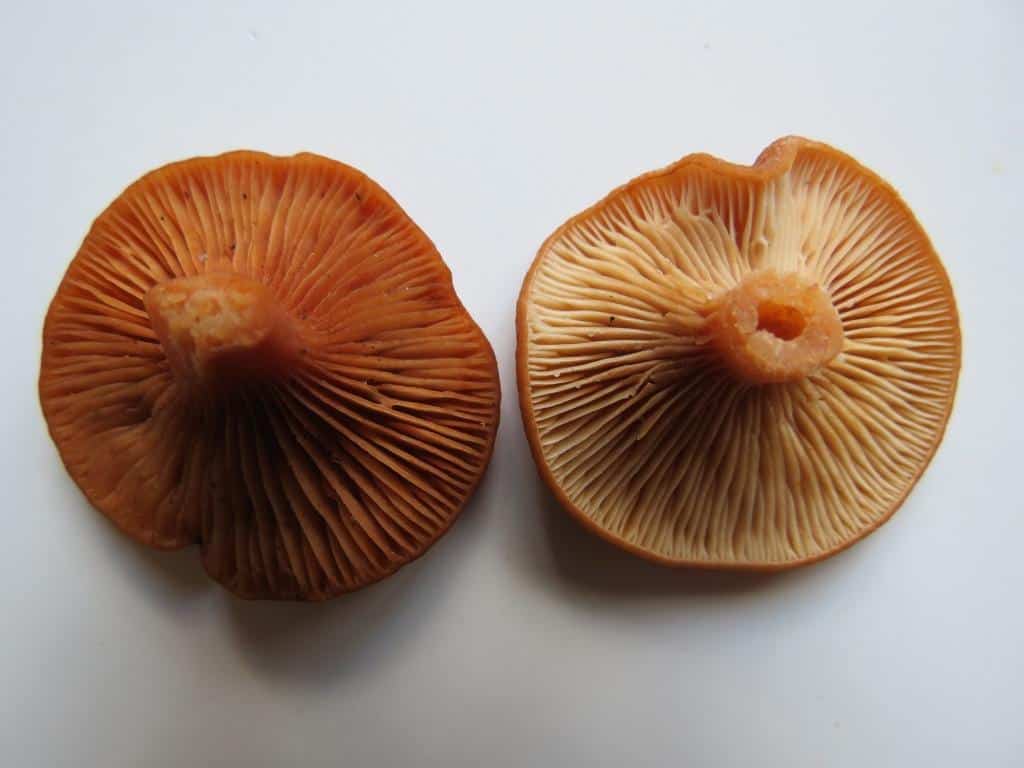Will the real Candy cap mushrooms please stand up?

It would be so much simpler if mushrooms sprouted with barcodes on their caps. While I have no doubt that some crazed geneticist is secretly working on doing just that, for now at least we need to stick to basic field identification methods. This odd little mushroom in the genus Lactarius came into notoriety, not for its fresh culinary use but as a result of the maple syrup aroma it gives off after being dried. The source of this interesting manifestation was uncovered by Dr. William F. Wood and you can read about it at the Humboldt State website. However, to get that aroma you first need to find where these little guys live and how to identify them. Since it generally doesn’t fruit in our area until later in the fall or early winter, people who favor the warmer hunting conditions of October may never encounter them. This year we picked our first candy cap mushrooms in later November.

We generally find them in mossy areas of 2nd growth conifer forests on and around very rotten old-growth stumps and logs. Although it is a mycorrhizal fungus, it really likes to hang out with old dead tree remnants that provide additional substrate to expand into. We find them mostly in the Lorane Valley and westward up to where the Coastal Mountain Range begins. We have also heard reports of people finding them in the Cascades. As you can see by the earlier picture with Sandy’s hand under a Candy Cap, the caps can be several inches in diameter. Their coloration is generally some variation of burnt orange and somewhat on the dull side. Caps are typically flat with a slight center depression and sometimes wavy at the margins.

They can also have a small bump or umbo in the center. The cap should have a texture like fine sandpaper and will never feel slimy or look glossy even when wet. If you break the cap open it will exude a latex that is clear to very thinly white somewhat like skim milk. It will never be solid white or change to yellow once the latex is exposed to air. You can always chew on a piece of the cap, and then spit it out to test the flavor. It should never be spicy, acrid, or bitter. The stem is typically the same color as the cap. Stems will be quite narrow on smaller ones but on larger ones can be up to 3/8 of an inch thick and will be hollow. The gills and stem can be quite light in color or a darker shade. Both will exude the same milky white latex and both taste the same. Our curiosity about the color variations led us to question if all the Candy Caps in our area are the same species. A discussion with Steve Trudell resulted in us sending samples of these two color variants (pictured below) to Professor Andrew Methven at Eastern Illinois University for DNA analysis back in 2013 but as I have found science can sometimes move at a snail’s pace.

We have found the cap is the most valuable part as the stems becoming quite tough after they are dehydrated. It is quite easy when harvesting to place two fingers under the cap, your thumb on top and simply snap it off the stem. The ground can look like a stem graveyard after you’re done harvesting but nature will reclaim what you have left behind. There are certainly look-alikes that exist next to and amongst the real Candy Cap mushrooms so always be certain they meet the complete criteria listed above. As for the correct scientific name for our Candy Cap mushroom, it is believed to be Lactarius fragilis variant rubidus although it has become acceptable to simply refer to it as Lactarius rubidus. There are other species of mushrooms in the genus Lactarius that are in the so-called Candy Cap group but none are believed to exist in our area. We may have more definitive species information once we hear back from Professor Methven regarding his DNA findings. I just hope his findings arrive before the Tsunami.

In any event, try your luck at finding this interesting mushrooms and don’t get discouraged if you get confused. It took us several years of drying every winter fruiting burnt orange mushroom we found until we finally found the real Candy Cap mushrooms. Keep in mind that the amount of maple aroma can vary greatly depending on the amount of water saturation in the ground when they fruit. The most aromatic collection we’ve had to date was during a mild and very dry fall and early winter. The conditions that year more directly mirrored those in California where their Candy Cap mushrooms seem to be more aromatic. The last suggestion is not to store them for an extended period of time since the maple flavor component seems to fade after a few years.
If you are successful, try making the classic Candy Cap mushroom cookies. You will find a version of this recipe in the CMS Wild Mushroom Cookbook, in David Arora’s All That the Rain Promises field guide or at Fat of the Land.
References
Books:
Mushrooms of the Redwood Coast – Noah Siegel and Christian Schwarz
David Arora – All That the Rain Promises and More….
Email Correspondence:
Steve Trudell – Mycologist & Author of Mushrooms of the Pacific Northwest
Darvin DeShazer – SOMA Science Advisor
Andrew Methven – Department of Biological Sciences Eastern Illinois University





